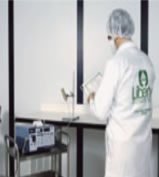Standards – Newsletter
Are there really any cleanroom standards today?
Yes.., But what do they actually mean?
Officially on November 29th, 2001, the United States General Services Administration (GSA) announced that Federal Standard 209E, Airborne Particulate Cleanliness Classes in Cleanrooms and Clean Zones, has been canceled and is superseded by ISO Standards for cleanrooms and associated controlled environments.
The new standards are: ISO 14644-1 Classification of air cleanliness and ISO 14644 -2 Specifications for testing and monitoring to prove continued compliance with ISO 14644-1.
The GSA, in doing this, has followed the recommendations made by Institute of Environmental Science and Technology’s (IEST) Working Group CC-100, chaired by Mr. Richard A. Matthews, to “sunset” Federal Standard 209E.
For those who are interested, copies of the ISO documents may be ordered through the IEST web site,
![]() www.iest.org or via email at publicationsales@iest.org.
www.iest.org or via email at publicationsales@iest.org.
Vol. 5, No. 1, page 2 March, 2002
As for this writer, please give me the “old days” with Federal Standard 209 – A, B, C or E. Those were the days when you knew what you were dealing with regarding particle counts, particle count locations and room pressure. With the adoption of the new ISO standards, today, it’s pot luck, “that’s it.”
During the Cleanroom East Show held last March, 2001, at the World Trade Center in Boston, in order to “see what was going on” with the new ISO standards and how the IEST Working Group CC-100 was proposing to address critical testing concerns, I attended the ISO-14644 Cleanroom Standards Tutorial T-3, titled: What They Are, What They Mean and How They Work.
The tutorial lasted about three hours and covered a wide range of issues regarding ISO-14644. I had attended with the hope of having all my concerns about these new global specifications once and for all.
ISO 14644-1 Reference cleanliness classes compared to English and SI classes:
Selected airborne particulate cleanliness classes for cleanrooms and clean zones:
The chart below shows the maximum concentration limits (particles/m3 of air) for airborne particles equal to and larger than the particle sizes shown.
| Iso Class | English
(209 E) |
SI
(209 E) |
0.1µm | 0.2 µm | 0.3µm | 0.5 µm | 1.0 µm | 5.0 µm |
| 1 | — | — | 10 | 2 | — | — | — | — |
| 2 | — | — | 100 | 24 | 10 | 4 | — | — |
| 3 | 1 | M1.5 | 1,000 | 237 | 102 | 35 | 8 | — |
| 4 | 10 | M2.5 | 10,000 | 2,370 | 1,020 | 352 | 83 | — |
| 5 | 100 | M3.5 | 100,000 | 23,700 | 10,200 | 3,520 | 832 | 29 |
| 6 | 1,000 | M4.5 | 1,000,000 | 237,000 | 102,000 | 35,520 | 8,320 | 293 |
| 7 | 10,000 | M5.5 | — | — | — | 355,200 | 83,200 | 2,930 |
| 8 | 100,000 | M6.5 | — | — | — | 3,520,000 | 832,000 | 29,300 |
| 9 | — | — | — | — | — | 35,200,000 | 8,320,000 | 293,000 |
| 1. µm = Micron
2. Reference class names are from FEDERAL STANDARD 209E in English and SI units. These classifications closely approximate the ISO class listed in the table above. |
||||||||
Unfortunately, I left more confused about the application of these new ISO Standards than when I went in. However, to their credit, the course instructors, Ken Goldstein and Mike Fitzpatrick, did a superb and intelligent job in teaching a difficult subject.
What I did get out of this seminar was that ISO Documents 14644-1 and 14644-2 will allow you to test “fewer” locations for cleanliness then Federal Standard 209E and allows you one outlier. While this term was new to me and seemed more nautical than technical, in actuality, it’s a single particle count that is excessively high or low. The ISO documents 14644-1 and 14644-2 also establish 0.1 µm as the “standard” particle diameter, and creates three (3) new cleanliness classes. Two (2) of these three (3) classes, Class 1 and 2, are “cleaner” than Federal Standard 209E’s Class 1 and the third (defined as Class 9) is “dirtier” than Federal Standard 209E’s Class 100,000.
Not one word was said in these new standards about airflow velocity, room pressure, room temperature, the distance from the floor or the filter face when taking an air sample for a particle count. And yet, as we all know, these factors are crucial in properly certifying the cleanliness level of a cleanroom-any cleanroom. Barring filter leaks, improperly mounted filters, gasket depression or holes, the farther the test is from to the filter media, the higher the particle count and the dirtier the results.

Vol. 5, No. 1, page 3 March, 2002
Conversely, the closer to the filter media, the lower the particle count and the cleaner the sample. If I take the particle-count sample six inches from the filter face, with no holes in the media or problems with the filter, I’m going to get either an ISO 144644-1 Class I or Federal Standard 209E Class 1/M1.5 particle count-guaranteed!
They do mention that testing and certification should be done either at rest, as built or in operation.
In my opinion with no specifications set forth on particle sampling distances from the floor or the filter face, it makes no difference at all when testing or certifying whether it’s at rest, as built or in operation. Again, if a particle count is sampled 6″ from the filter face with no holes in the media or if these are no problems with the filters, you will get an ISO 144644-1 Class 1 or Federal Standard 209E Class 1/M1.5 particle count! No air flow velocity is mentioned in the ISO specification! Talking about making it easy to certify a room! Wow! Like taking candy from a baby.
When I questioned the course instructors about this matter they stated it was up to the user and contractor. Huh? If the user is not fully educated on class certification and doesn’t know what he wants and asks the contractor, what do you think is going to happen? Some where, some how, too much will be left to chance. It doesn’t make the industry look very professional.
Our experience has been that many customers calling about a cleanroom for the first time become very confused with the mountains of specifications from Federal Standard 209A, B, C, D and E, Mil Standards, Air Force Tech Orders, IEST Recommended Practices, NASA Specifications. Where does it end? Well, I too am confused! It’s whatever you want. Right or wrong-or anywhere in between!
Mr. Richard A. Matthews, chairman of the ISO technical committee ISO/ TC209, in his series of nine articles which appeared in CleanRooms Magazine, April thru December of 2000, entitled: “The ISO Global Cleanroom Standards what do they really mean?”, wrote how these new ISO Specifications were the “mother of all standards” and were going to sunset all the Federal Standard 209’s, and everything else on the block.
Likewise, it seemed that these standards would cure all our ills in the cleanroom industry. Well, I learned from my course instructors that, at that point in time, both the GSA and the FDA have not approved the ISO Standards. I also learned that the FDA was not even a member of the ISO Technical committee that had written ISO 14644-1 and 2. And, it may be a year down the road, possibly two to three years, maybe four or never before FDA approves the ISO Standards “How’s that!” It goes to show you, you can’t believe everything you read or hear.
I guess, in view of what happened on November 29th, he was right!
As it turned out, in less than one year from the date of my seminar, ISO 14644-1 and ISO 14622-2 have become recommended cleanroom standards.
Vol. 5, No. 1, page 4 March, 2002
Anne Marie Dixon’s article in June 2001 Issue of Cleanrooms Magazine, “Hurry up and Wait,” stated that she also wanted to know what was the status of Federal Standard 209E. Just goes to show you that the industry was confused. She also stated “As leaders in the field of cleanrooms, we as a country have become the focus of jokes in the international community, as the country that leads but can’t make changes.”
Right or wrong, effective November 29th, 2001 Ms. Dixon has her answer. Federal Standard 209E has been “put out to pasture” or more technically, “sunset” by the GSA! guess, we’ve finally made the change – for better or worse!
As I said before, for this writer, please give me the “old days” with Federal Standard – 209A, B, C or E, when you knew what you were dealing with regarding particle classifications, air flow velocities, particle counts, particle count locations and room pressure. Today, it’s pot luck, “that’s it”.
Writer’s opinion: This is this writer’s opinion only and not necessarily the opinion of Liberty Industries, Inc. or it’s employees. I don’t mean to be sarcastic, but coming from the old school it makes one think, “What’s happening here?”

How to Save Thousands on Your New Cleanroom – Volume 5, No. 1 in a series of publications from Liberty that makes understanding cleanroom design clear and simple. Utilizing a question and answer format like our previous Cleanroom Primer, Air Shower Primer and Maintenance Primer, the design primer simplifies a complicated subject. 56 pages. Don’t buy a cleanroom until you’ve read this publication. It will save you thousands – I promise.
Cleanroom News™
Published by John J. Nappi, Jr.



